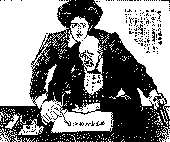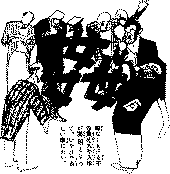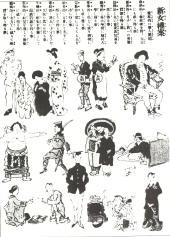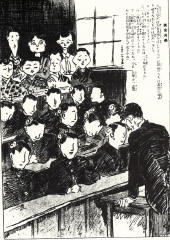 ; 2.->
; 2.-> ; 3.->
; 3.-> ; 4->
; 4->
Four cartoons from the print media circa 1919. Click on each image above to view a larger version.
1.The first cartoon is a warning to Japanese readers not to follow the course of Britain, where women were a 1913 law guaranteed women the right to vote. It features a woman forcing Lloyd George to sign the law at gunpoint. The original English caption reads: "English lady dictating Loyd George a bill for woman's suffrage [sic]."
2. The next features the character 姦, which is comprised of three 女elements. 女 means "woman," and so 姦 suggests a group of women. 姦 is read "kashimashii" and it means "loud" or "noisy." The original English caption to this cartoon reads: "Women are noisy creatures. No wonder that the admittance of three of them into the T˘hoku University is causing so much noise throughout the land. Admittance of women to universities was one of the typical demands of the woman's movement of this time.
3. Number three is entitled "The New Women's Bill of Rights" 新女権案. The rights are as follows (the order of the written text doe snot follow the order of the images perfectly, but it should be obvious which image corresponds each item below):
Politically: to attain the right to participate in politics and even to become cabinet ministers
Legally: to be the same as men in hiring and wages
Educationally: admittance to any university
Militarily: to become soldiers and even to enter military academies
Religiously: to be allowed to marry, even in the case of Buddhist nuns
Socially: to require men to pour liquor (for women) at banquets
In the home: to make husbands care for children and cook meals
Biologically: to regard pregnancy as a form or labor and to be paid the highest wages for it
In terms of appearance: to abolish keppatsu (hair arranged in a knot) and to get haircuts
Artistically: for women to compete in sum˘
Most of all of these "rights" would have struck the typical reader of the time as absurd.
4. This one is about the demands for women to enter universities and is entitles "Coeducation" 男女共教. It shows the male students seated in front, but with blank faces. Their eyes have all migrated to the backs of their heads. The point, of course, is that women should not be admitted to universities because their presence would distract men. Incidentally, women at this time and earlier could pursue higher education at private women's colleges. But by 1919, there was increasing pressure to allow academically qualified women into the mainstream public universities.
This cartoon may not be entirely wrong. According to many "how to study" or "how to get good grades" type of guidebooks, surveys of contemporary U.S. college students reveal that at any given time in a typical lecture class only about 10-20% of a class are fully mentally engaged with the material at hand. The rest of the class, if awake, is daydreaming to at least some extent. And what do you think is the overwhelmingly popular subject of those daydreams--for either men or women?